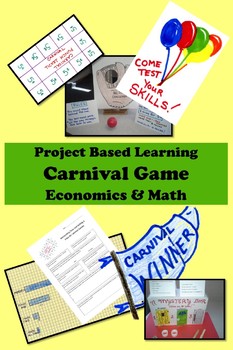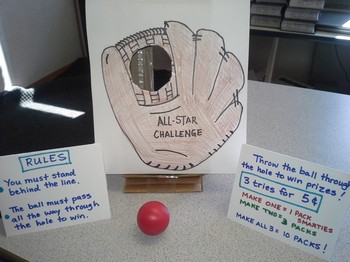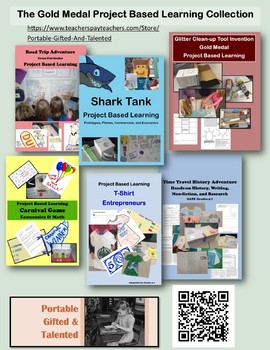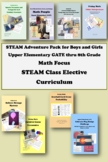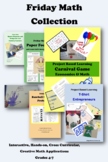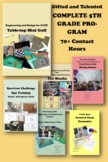Carnival Game Economics PBL Project-Based Learning GATE
Portable Gifted and Talented
3.1k Followers
Grade Levels
4th - 7th
Subjects
Resource Type
Standards
CCSS4.MD.A.2
CCSS5.MD.B.2
CCSS4.OA.A.2
CCSS4.NF.A.2
CCSS6.SP.A.1
Formats Included
- Word Document File
Pages
30 pages
Portable Gifted and Talented
3.1k Followers
What educators are saying
This was great! I loved watching my students turn "trash" into a carnival game. This required creative thinking and problem solving. Great resource.
Also included in
- Let’s get ready for the second semester, you rock star gifted and talented teacher, you . . .By now the students can’t wait for their next group with you, so let’s not disappoint!Priced at more than 44% off individual purchases, I put this collection together with several things in mind:1. Best pracPrice $22.99Original Price $44.93Save $21.94
- Pretty much everything in the Portable Gifted and Talented store is rated 4.0, but take a couple minutes to peruse the comments for these individual units. I think you’ll like what you see.Designed for two purposes:A curriculum for Middle School STEAM classes with MATH focus. Or . . .Upper ElementPrice $18.99Original Price $35.94Save $16.95
- Engage iGen students with real-world, hands-on project-based and collaborative units! 6 Gold Medal units for grades 3-8 at 50% off the individual prices. That's a great deal for fantastic units--250+ pages--all ready to go tomorrow!SEE THE BIG PREVIEW FOR INDIVIDUAL UNIT DETAILSYou get the followinPrice $24.99Original Price $34.94Save $9.95
- Kid-tested and very popular! But don't let that fool you . . . these are very challenging.Please see individual previews.Price $15.99Original Price $21.47Save $5.48
- Hours and hours and hours! Ready to go today!One of the best purchases I made in my early career was a book of guidelines for teaching gifted students. It contained a few samples of what sort of work these students might do. I’ve often lent it to colleagues over the years. What I really needed, tPrice $39.99Original Price $79.37Save $39.38
- GT kids in my school start talking about these units in 2nd grade and can't wait to be "big" kids . . .Every other teacher in your building probably has a handy curriculum to follow, a set of textbooks as resources . . . so why not you, the Gifted and Talented Teacher?Here is a complete 5th grade GAPrice $25.99Original Price $35.94Save $9.95
Description
Smaller tasks add up to big, big learning with this gold medal standard project-based learning activity! What a sneaky cool way to learn math, economics, and functional design! (Insert evil teacher laugh.) It’s a hands-on approach to Common Core Standards.
In Carnival Game Economics, students design a carnival skill game and gather data as junior market researchers during the test phase. They’ll use this data to help make decisions. After making calculations for probability, students will use pricing options and economic decisions in an attempt to turn a profit with their game of chance or skill. Finally, in an authentic assessment, students invite another classroom(s) to come try out the carnival games for fun and prizes.
Here are real-world math, economics, and functional design from the Common Core Standards together in a highly engaging activity—21st Century Learners at their finest! In this activity, students become 3D designers, engineers, mathematicians, economists, and business owners who collaborate to produce an authentic product.
We want learners who can think critically, ask important questions, design and plan based on probabilities, logic, and inference—the skills of responsible citizens.
Here the teacher is not the sage on the stage by a guide and support. There are a few mini lessons (provided) you may want to teach—depending on the background knowledge of your students.
This lesson comes with detailed teacher directions, sample answers and a scoring rubric, several ready-to-print activity sheets which guide students through critical thinking in economics and math, and photos which clarify the process.
Carnival Game Economics is appropriate for 4th grade GATE students through 7th grade.
Level—4th GATE through 7th
Materials—“Junk drawer items” and cardboard, tape, common craft materials.
Time: More than 6 hours, depending on level and pacing/revision/sharing.
In Carnival Game Economics, students design a carnival skill game and gather data as junior market researchers during the test phase. They’ll use this data to help make decisions. After making calculations for probability, students will use pricing options and economic decisions in an attempt to turn a profit with their game of chance or skill. Finally, in an authentic assessment, students invite another classroom(s) to come try out the carnival games for fun and prizes.
Here are real-world math, economics, and functional design from the Common Core Standards together in a highly engaging activity—21st Century Learners at their finest! In this activity, students become 3D designers, engineers, mathematicians, economists, and business owners who collaborate to produce an authentic product.
We want learners who can think critically, ask important questions, design and plan based on probabilities, logic, and inference—the skills of responsible citizens.
Here the teacher is not the sage on the stage by a guide and support. There are a few mini lessons (provided) you may want to teach—depending on the background knowledge of your students.
This lesson comes with detailed teacher directions, sample answers and a scoring rubric, several ready-to-print activity sheets which guide students through critical thinking in economics and math, and photos which clarify the process.
Carnival Game Economics is appropriate for 4th grade GATE students through 7th grade.
Level—4th GATE through 7th
Materials—“Junk drawer items” and cardboard, tape, common craft materials.
Time: More than 6 hours, depending on level and pacing/revision/sharing.
Total Pages
30 pages
Answer Key
N/A
Teaching Duration
N/A
Report this resource to TPT
Reported resources will be reviewed by our team. Report this resource to let us know if this resource violates TPT’s content guidelines.
Standards
to see state-specific standards (only available in the US).
CCSS4.MD.A.2
Use the four operations to solve word problems involving distances, intervals of time, liquid volumes, masses of objects, and money, including problems involving simple fractions or decimals, and problems that require expressing measurements given in a larger unit in terms of a smaller unit. Represent measurement quantities using diagrams such as number line diagrams that feature a measurement scale.
CCSS5.MD.B.2
Make a line plot to display a data set of measurements in fractions of a unit (1/2, 1/4, 1/8). Use operations on fractions for this grade to solve problems involving information presented in line plots. For example, given different measurements of liquid in identical beakers, find the amount of liquid each beaker would contain if the total amount in all the beakers were redistributed equally.
CCSS4.OA.A.2
Multiply or divide to solve word problems involving multiplicative comparison, e.g., by using drawings and equations with a symbol for the unknown number to represent the problem, distinguishing multiplicative comparison from additive comparison.
CCSS4.NF.A.2
Compare two fractions with different numerators and different denominators, e.g., by creating common denominators or numerators, or by comparing to a benchmark fraction such as 1/2. Recognize that comparisons are valid only when the two fractions refer to the same whole. Record the results of comparisons with symbols >, =, or <, and justify the conclusions, e.g., by using a visual fraction model.
CCSS6.SP.A.1
Recognize a statistical question as one that anticipates variability in the data related to the question and accounts for it in the answers. For example, “How old am I?” is not a statistical question, but “How old are the students in my school?” is a statistical question because one anticipates variability in students’ ages.

